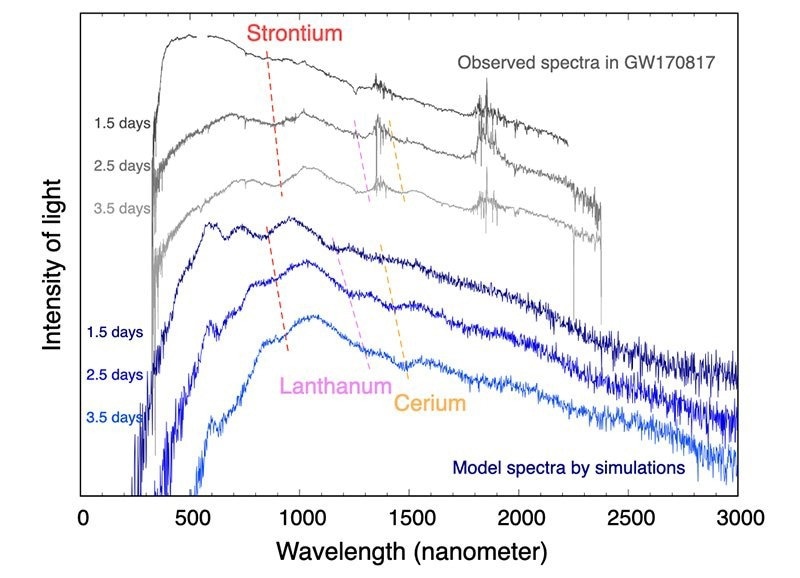Reviewed by Mila PereraOct 28 2022
For the first time, a team of scientists has detected rare earth elements formed by the merging of neutron stars.

The observed spectra of a kilonova (gray) and model spectra were obtained in this study (blue). The numbers on the left show the days after the neutron star merger occurred. Dashed lines indicate the features of the absorption lines. The names of the elements that produce these features are shown in the same colors as the dashed lines. The spectra are vertically shifted for visualization. The observed spectra around 1400 nanometers and 1800-1900 nanometers are affected by the earth's atmosphere. Image Credit: ©Nanae Domoto
Details of this unique occurrence can be found in the October 26th, 2022 issue of The Astrophysical Journal.
When two neutron stars spiral inward and unite, the ensuing blast creates a huge quantity of heavy elements that compose the Universe. The first verified example of this development was an occurrence in 2017 known as GW 170817. However, even five years later, detecting the precise elements formed in neutron star unions has evaded researchers, apart from strontium recognized in the optical spectra.
A research team directed by Nanae Domoto, a graduate student at the Graduate School of Science at Tohoku University and a research fellow at the Japan Society for the Promotion of Science (JSPS), has methodically explored the features of all heavy elements to decipher the spectra from neutron star unions.
The team used this to examine the spectra of kilonova - bright emissions resulting from the radioactive decay of newly synthesized nuclei that are expelled during the union - from GW 170817.
Based on evaluations of comprehensive kilonovae spectra simulations created by the supercomputer "ATERUI II" at the National Astronomical Observatory of Japan, the researchers learned that the rare elements cerium and lanthanum can replicate the near-infrared spectral features witnessed in 2017.
The reality of rare earth elements has previously only been theorized based on the general development of the kilonova's brightness, but not from the spectral properties.
This is the first direct identification of rare elements in the spectra of neutron star mergers, and it advances our understanding of the origin of elements in the Universe. This study used a simple model of ejected material. Looking ahead, we want to factor in multi-dimensional structures to grasp a bigger picture of what happens when stars collide.
Nanae Domoto, Study Lead and Graduate Student, Graduate School of Science, Tohoku University
Journal Reference
Dotomo, N., et al. (2022) Lanthanide Features in Near-infrared Spectra of Kilonovae. The Astrophysical Journal. doi.org/10.3847/1538-4357/ac8c36.